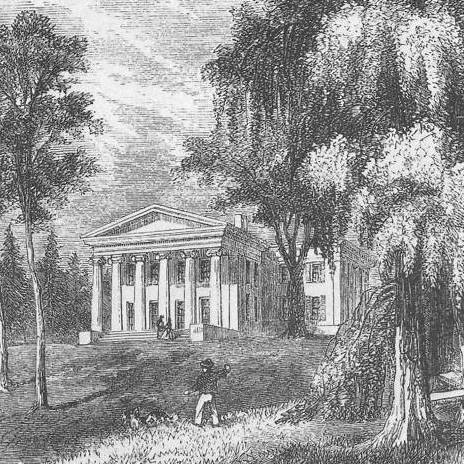Nevis: Estate honors Founding Father Alexander Hamilton
The third son of American Founding Father Alexander Hamilton, Colonel James Alexander Hamilton and wife Mary Morris purchased a 150-plus acre property at 136 S. Broadway, Irvington, between Broadway and the Hudson River in 1834 and built a mansion there a year later. The estate was named Nevis in honor of the island in the British West Indies where his famed father was born.
James A. Hamilton served as Acting Secretary of State in March 1829 under U.S. President Andrew Jackson and served as a Brigade Major in the New York State Militia in the War of 1812.
He was a practicing attorney and prosecutor and was 16 years old when his father was mortally wounded in his infamous duel with U.S. Vice President Aaron Burr at Weehawken, N.J., on July 11, 1804, three years after Hamilton’s oldest son Philip was shot and killed in a duel at the same location across the Hudson River from Manhattan.
 |
| Pictured, ca. 1904, are the actual flintlock pistols used in the Aaron Burr-Alexander Hamilton duel, on 11 July 1804 at Weehawken, N.J. The pistols were by London gunsmith Wogdon & Barton. (Wikimedia Commons) |
Along with his mother and surviving siblings, James was at his father's bedside in a Greenwich Village boarding house when Hamilton died on July 12, 1804.
The Nevis mansion was enlarged and faced in brick in 1884 after being inherited by J.A. Hamilton’s son, Colonel Alexander Hamilton III. His cousin, Philip Schuyler, who held a smaller neighboring property by the river, inherited Nevis from Hamilton in 1889 and combined the properties into one estate.
 |
This is a ca. 2015 photo of the south face of the Nevis mansion, a building originally constructed in 1835 and rebuilt and renovated many times since. (Wikimedia Commons) |
Schuyler’s great-grandparents included Founding Father Hamilton and Revolutionary War General Philip Schuyler.
The estate changed hands several times after 1906, including to Charles Eastman Danforth Sr., a prominent Wall Street stockbroker, eventually being purchased by U.S. Senator Thomas Coleman DuPont of Delaware in 1920. In 1934, DuPont’s wife donated the house and its remaining 68 acres to Columbia University.
Columbia constructed a physics lab on the 60-acre site and, in 1950, dedicated the world’s most powerful particle accelerator -- a cyclotron -- with Columbia president -- and future U.S. -- president Dwight D. Eisenhower on hand. The cyclotron was decommissioned in 1976, but the house and lab remain in use by Columbia today as a physics and biological research facility known as Nevis Laboratories.
Columbia physics professor John Parsons once explained the practical modern side of the cyclotron particle accelerator to journalist Barbara Moroch of The Hudson Independent newspaper:
“Most of today’s particle accelerators are not used for physics research, but in hospitals and in industry, for purposes such as cancer therapy and fabrication of materials. Many medical devices, such as X-ray machines, MRIs and PET scanners all were developed first in labs. In fact, the World Wide Web was developed at CERN (the European Organization for Nuclear Research based in Switzerland) to improve communication among physicists. It was then provided, free of charge, to the world.”
Today’s Nevis Laboratories specializes in designing and building high-energy particle and nuclear experiments and equipment distributed to major laboratories worldwide. The lab also performs data analysis for those experiments.
The laboratory is home, too, to the Radiological Research Accelerator Facility, a National Institute of Biomedical Imaging and Bioengineering biotechnology resource center specializing in microbeam technology.
Columbia University hosts regular free public lectures at the estate’s Nevis Science Center, a repurposed barn from the heyday of the estate.
The presentations were suspended during the 2020 COVID-19 pandemic, but are normally held the second Thursday of each month during the school year. Columbia physicists and scientists discuss international and local experiments on which their research teams are working. Topics include such items as big bang cosmology, dark matter, neutrino physics, particle colliders, biophysics and astrophysics.












Comments
Post a Comment
If you would like to weigh-in, feel free ...